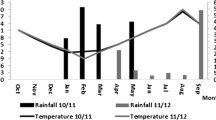Summary
In northern Victoria Land (continental Antarctica, between 72° and 76°S, 162° and 169°E), 18 moss samples have been collected and analysed for the presence of pollen. In turfs and cushions of 8 different moss species, at least 27 pollen taxa could be identified. The pinus-type pollen and those of grasses were very common. More than 60% of the total grains were damaged or could not be identified. There is evidence that the Antarctic continent could act as a sink for wind-transported pollen from sub-Antarctic islands or from plants (native or cultivated) in South America, Australia, New Zealand and South Africa. However, the pollen concentration in air (⩽ 1 pollen grain/100 m3) and its entrapment rate on moss (about 0.12 grain/cm2/year) result in a very low pollen density in these plants.
Similar content being viewed by others
References
Barrow CJ (1978) Postglacial pollen diagrams from South Georgia (sub-Antarctic) and West Falkland Islands (South Atlantic). J Biogeogr 5:251–274
Boyd WE (1986) The role of mosses in modern pollen analysis: The influence of moss morphology on pollen entrapment. Pollen Spores 28:243–256
Broady PA (1984) Taxonomic and ecological investigations of algae on steam-warmed soil on Mt Erebus, Ross Island, Antarctica. Phycologia 23:257–271
Broady PA, Given D, Greenfield L, Thompson K (1987) The biota and environment of fumaroles on Mt. Melbourne, northern Victoria Land. Polar Biol 7:97–113
Campo M van (1974) Pollen et spores d'Afrique tropicale. Centre d'Etu–1 de Geogr Trop, CNRS, Paris, p 205
Carroll F (1943) The use of bryophytic polsters and mats in the study of recent pollen deposition. Am J Bot 30:361–366
Erdtman G (1952) Pollen morphology and plant taxonomyAngiosperms. An introduction to Palynology. Almquist & Wiksel, Stockholm, p 537
Faegri K, Iversen J (1964) Textbook of pollen analysis. Blackwell Sci Publ Oxford, p 228
Folkeson L (1979) Interspecies calibration of heavy-metal concentrations in nine mosses and lichens. Applicability to deposition measurements. Water Air Soil Pollut 11:253–260
Greene DM (1986) A conspectus of the mosses of Antarctica, South Georgia, the Falkland Islands and Southern South America. Br Antarct Surv Bull, Cambridge, p 314
Heusser CJ (1971) Pollen and spores of Chile. Univ Arizona Press, Tuesten, p 167
Hyde HA, Adams HF (1958) An atlas of airborne pollen grains. McMillan & Co, London, p 250
Ino Y (1990) Field measurement of net photosynthesis of mosses at Langhovde, East Antarctica. Ecol Res 5:195–205
Kanda H (1981) Flora and vegetation of mosses in ice-free areas of Soya Coast and Prince Olav Coast, East Antarctica. Hikobia, [Suppl 1] 91–100
Kappen L, Straka H (1988) Pollen and spores transport into the Antarctic. Polar Biol 8:173–180
Lewis WH, Vinay P, Zenger VE (1983) Airborne and allergenic pollen of North America. John Hopkins Univ Press, Baltimore, p 254
Linskens HF (1992) Mature pollen and its impact on plant and man. In: Cresti M, Tiezzi A (eds) Research in sexual plant reproduction. Springer Berlin 201–216
Linskens HF, Ciampolini F, Cresti M (1989) Restained dehiscence results in stressed pollen. Proc Kon Ned Akad Wetensch (Amsterdam) 92:465–475
Linskens HF, Bargagli R, Focardi S, Cresti M (1991) Antarctic moss turf as pollen traps. Proc Kon Ned Akad Wetensch (Amsterdam) 94:233–241
Longton RE (1973) A classification of terrestrial vegetation near McMurdo Sound, continental Antarctica. Can J Bot 51:2339–2346
Longton RE (1985) The biology of polar bryophytes and lichens Cambridge Univ Press, Cambridge, p 391
Markgraf V, D'Antoni HL (1978) Pollen flora of Argentina. Modern spore and pollen types of Pteridophyta, Gymnospermae, and Angiospermae. Univ Arizona Press, Tucson, p 208
Nakanishi S (1977) Ecological studies of the moss and lichen communities in ice-free areas near Syowa Station, Antarctica. Antarct Rec 59:68–96
Nair PKK, Joshi AP, Gangal SV (1986) Airborne pollen, spores and other plant material of India. A survey. Rep India Coord Proj Aerobiol, CSIR, Lucknow, p 189
Niklas KJ (1981) Airflow pattern around some early seed plant ovules and cupules: implications concerning efficiency in wind pollination. Am J Bot 68:635–650
Nilsson S, Praglowski J, Nilsson L (1977) Atlas of airborne pollen grains and spores in northern Europe. Natur och Kultur, Stockholm, p 159
Pike KM (1956) Morphology of Myrtaceae from south-west Pacific area. Aust J Bot 4:13–53
Pohl F (1937) Die Pollenerzeugung der Windblüter. Beih Bot Zbl 56:365–470
Ruhling A, Tyler G (1971) Regional differences in the deposition of heavy metals over Scandinavia. J Appl Ecol 8:497–507
Salas MR (1983) Long-distance pollen transport over the southern Tasman Sea: evidence from Macquarie Island. N Z J Bot 21:285–292
Scott L, Zinderen Bakker EM (1985) Exotic pollen and longdistance wind dispersal at a subantarctic island. Grana 24:45–54
Smith RIL (1984) Terrestrial plant biology of the sub-Antarctic and Antarctic. In: RM Laws (ed) Antarctic Ecology, Vol 1, Academic Press, London, 61–162
Tyler (1990) Bryophytes and heavy metals: a literature review. Bot J Linn Soc 104:231–253
Walton DWH (1984) The terrestrial environment. In: RM Laws (ed), Antarctic Ecology, Vol I, Academic Press, London, 1–34
Woodhouse ERP (1959) Pollen grains. Hafner Publ Co, New York, p 537
Zanten BO van (1983) Possibilities of long-distance dispersal in bryophytes with special reference to the Southern Hemisphere. Naturwiss V Hamburg 7:49–64
Author information
Authors and Affiliations
Rights and permissions
About this article
Cite this article
Linskens, H.F., Bargagli, R., Cresti, M. et al. Entrapment of long-distance transported pollen grains by various moss species in coastal Victoria Land, Antarctica. Polar Biol 13, 81–87 (1993). https://doi.org/10.1007/BF00238539
Received:
Accepted:
Issue Date:
DOI: https://doi.org/10.1007/BF00238539




